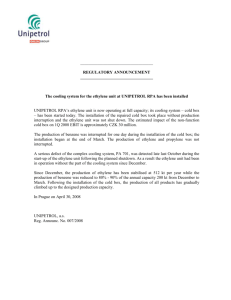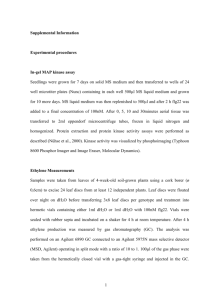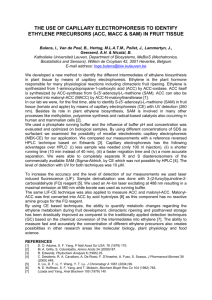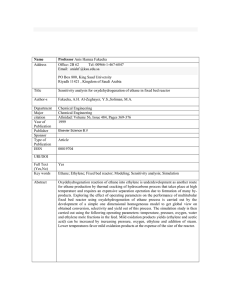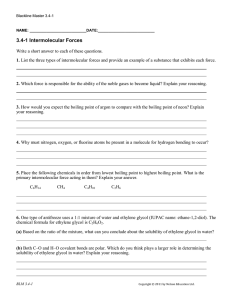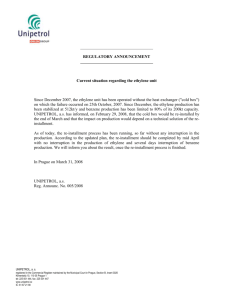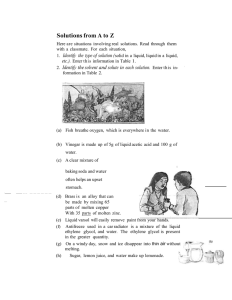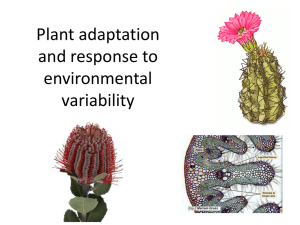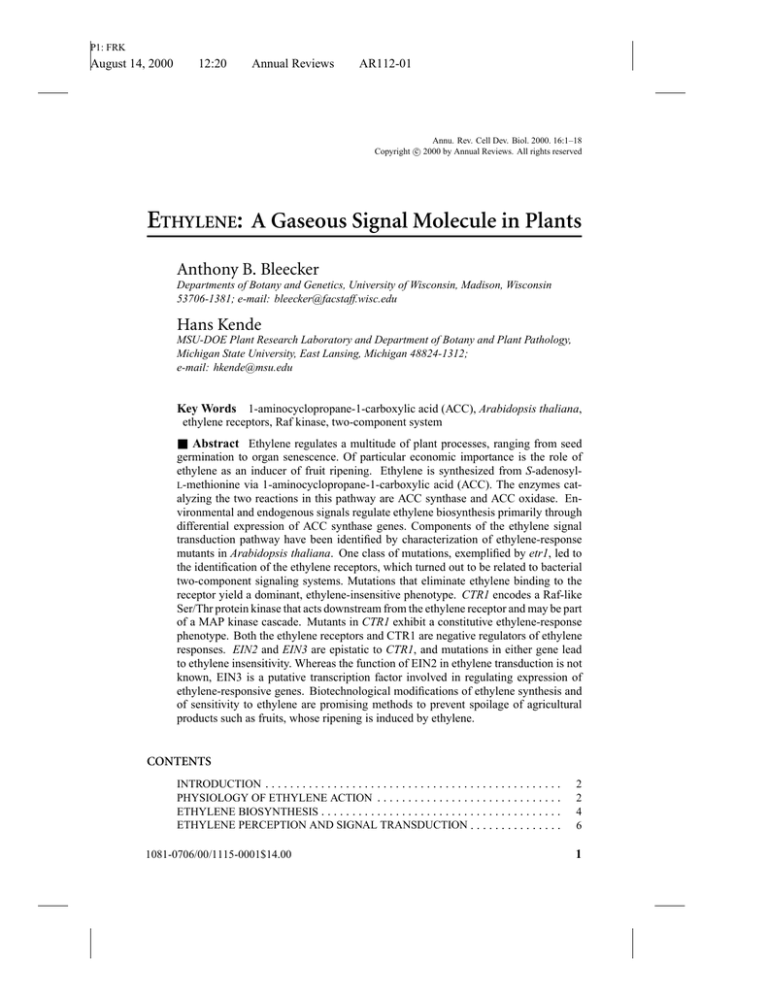
P1: FRK
August 14, 2000
12:20
Annual Reviews
AR112-01
Annu. Rev. Cell Dev. Biol. 2000. 16:1–18
c 2000 by Annual Reviews. All rights reserved
Copyright ETHYLENE: A Gaseous Signal Molecule in Plants
Anthony B. Bleecker
Departments of Botany and Genetics, University of Wisconsin, Madison, Wisconsin
53706-1381; e-mail: bleecker@facstaff.wisc.edu
Hans Kende
MSU-DOE Plant Research Laboratory and Department of Botany and Plant Pathology,
Michigan State University, East Lansing, Michigan 48824-1312;
e-mail: hkende@msu.edu
Key Words 1-aminocyclopropane-1-carboxylic acid (ACC), Arabidopsis thaliana,
ethylene receptors, Raf kinase, two-component system
■ Abstract Ethylene regulates a multitude of plant processes, ranging from seed
germination to organ senescence. Of particular economic importance is the role of
ethylene as an inducer of fruit ripening. Ethylene is synthesized from S-adenosylL-methionine via 1-aminocyclopropane-1-carboxylic acid (ACC). The enzymes catalyzing the two reactions in this pathway are ACC synthase and ACC oxidase. Environmental and endogenous signals regulate ethylene biosynthesis primarily through
differential expression of ACC synthase genes. Components of the ethylene signal
transduction pathway have been identified by characterization of ethylene-response
mutants in Arabidopsis thaliana. One class of mutations, exemplified by etr1, led to
the identification of the ethylene receptors, which turned out to be related to bacterial
two-component signaling systems. Mutations that eliminate ethylene binding to the
receptor yield a dominant, ethylene-insensitive phenotype. CTR1 encodes a Raf-like
Ser/Thr protein kinase that acts downstream from the ethylene receptor and may be part
of a MAP kinase cascade. Mutants in CTR1 exhibit a constitutive ethylene-response
phenotype. Both the ethylene receptors and CTR1 are negative regulators of ethylene
responses. EIN2 and EIN3 are epistatic to CTR1, and mutations in either gene lead
to ethylene insensitivity. Whereas the function of EIN2 in ethylene transduction is not
known, EIN3 is a putative transcription factor involved in regulating expression of
ethylene-responsive genes. Biotechnological modifications of ethylene synthesis and
of sensitivity to ethylene are promising methods to prevent spoilage of agricultural
products such as fruits, whose ripening is induced by ethylene.
CONTENTS
INTRODUCTION . . . . . . . . . . . . . . . . . . . . . . . . . . . . . . . . . . . . . . . . . . . . . . . .
PHYSIOLOGY OF ETHYLENE ACTION . . . . . . . . . . . . . . . . . . . . . . . . . . . . . .
ETHYLENE BIOSYNTHESIS . . . . . . . . . . . . . . . . . . . . . . . . . . . . . . . . . . . . . . .
ETHYLENE PERCEPTION AND SIGNAL TRANSDUCTION . . . . . . . . . . . . . . .
1081-0706/00/1115-0001$14.00
2
2
4
6
1
P1: FRK
August 14, 2000
2
12:20
BLEECKER
Annual Reviews
¥
AR112-01
KENDE
Genetics of Ethylene Signal Transduction . . . . . . . . . . . . . . . . . . . . . . . . . . . . . 7
Biochemistry of Ethylene Signal Transduction . . . . . . . . . . . . . . . . . . . . . . . . . . 8
BIOTECHNOLOGICAL APPLICATIONS . . . . . . . . . . . . . . . . . . . . . . . . . . . . . . 13
OPEN QUESTIONS AND FUTURE PROSPECTS . . . . . . . . . . . . . . . . . . . . . . . . 13
INTRODUCTION
Ethylene, the simplest unsaturated hydrocarbon, regulates many diverse metabolic
and developmental processes in plants. The history of its discovery as a signal
molecule or plant hormone was described by Abeles et al (1992). In the nineteenth
century, several articles appeared reporting that leaks in illuminating gas caused
premature senescence and defoliation of plants in greenhouses and of trees near
gas lines. The Russian plant physiologist Neljubov (1879–1926) (Abeles et al
1992) observed that etiolated pea seedlings grew horizontally in his laboratory but
upright in outside air and showed that the abnormal growth habit was caused by
contaminating illuminating gas. In 1901, he proved that the active principle in
illuminating gas was ethylene. Thus Neljubov is credited with the discovery that
ethylene is a biologically active gas. Chemical proof that plants produce ethylene
was provided by Gane (1934), who analyzed the gases released by 60 lbs of
ripening apples. Thus the stage was set to investigate the function of ethylene as an
endogenous signal molecule in plants. Much of the early work on ethylene action
was performed at the Boyce Thompson Institute, then located in Yonkers, New
York (Crocker 1932). Mainly, the group at this institute provided a bioassay for
ethylene. This test was based on the so-called triple response of etiolated pea
seedlings, which consists of agravitropic (horizontal) growth, inhibition of stem
elongation, and thickening of the stem. The triple response proved to be quite
insensitive for measuring physiological levels of ethylene, but a modification of it
has served well for the identification of Arabidopsis mutants with altered ethylene
biosynthesis or sensitivity (Bleecker et al 1988, Guzmán & Ecker 1990). Modern
research on ethylene production by plant tissues and on the biological activity of
ethylene began with the introduction of gas chromatography (Burg & Stolwijk
1959). This new analytical technique permitted accurate and rapid determination
of trace amounts of ethylene.
PHYSIOLOGY OF ETHYLENE ACTION
The range of physiological responses regulated by ethylene is surprisingly wide
and has been described by Abeles et al (1992) and Mattoo & Suttle (1991). The
following is a synopsis of ethylene-controlled plant processes. In the broadest
of terms, ethylene triggers senescence of plant organs, it influences plant growth,
it acts as a stress hormone during biotic and abiotic stress conditions, and it exhibits
P1: FRK
August 14, 2000
12:20
Annual Reviews
AR112-01
ETHYLENE: A SIGNAL MOLECULE IN PLANTS
3
various morphogenetic effects. Among the senescence processes, ethyleneinduced ripening of so-called climacteric fruits has been investigated most intensively because of its great agronomic importance. Climacteric fruits, which
include many of our common fruits such as apples, bananas, cantaloupe, and
tomatoes, are characterized by a steep increase in ethylene synthesis at the mature
green stage and by a concomitant rise in respiration. Fruit ripening is a sequence of
biochemical events resulting in loss of chlorophyll, formation of pigments, flavors,
and aromas, softening of the flesh, and eventual abscission of the fruit. Whereas
in nature these processes ensure dispersal of seeds by animals that eat the fruits,
in agriculture the rate at which ripening occurs must be controlled to prevent
spoilage of fruits on the way to the consumer. Before the advent of biotechnology,
this was accomplished, for example, by removal of ethylene in hypobaric storage
compartments. Today, fruit ripening can be controlled by manipulating ethylene
synthesis or sensitivity using molecular techniques (see BIOTECHNOLOGICAL
APPLICATIONS). Other senescence processes regulated by ethylene are fading
of flowers and abscission of leaves and petals. Fading of flowers shares many similarities with ripening of climacteric fruits. It too can now be delayed by reducing
synthesis or sensitivity to ethylene with biotechnological methods.
A number of vegetative growth processes are regulated by ethylene, most notably induction of asymmetric stem and petiole growth. One such response, promotion of agravitropic growth, has already been mentioned in the context of the
triple response. Another asymmetric growth response to ethylene is the formation
of the apical hook, which protects the apex and the young leaves of dicotyledonous
plants as they push through the soil. Whereas stem elongation of terrestrial plants
is, in general, inhibited by ethylene, growth of semiaquatic plants, such as rice, is
strongly promoted.
Almost all biotic and abiotic stress conditions elicit ethylene synthesis in plants.
In some instances, ethylene appears to be involved in mediating the response
to stress. In other instances, the physiological function of stress ethylene is not
understood. The role of ethylene in pathogen-infected plants has been reviewed
and further investigated by Hoffman et al (1999), who studied resistance to various
pathogens in ethylene-insensitive mutants of soybean. Their results illustrate the
complexity of the phenomenon. Depending on the pathogen, disease symptoms
seem to be either reduced or enhanced by ethylene, or are not affected. In other
words, ethylene appears to mediate defense responses to some pathogens and to
suppress them to others. It has been suggested that ethylene helps to restrict the
spread of a pathogen by causing leaf abscission in cases where it exacerbates
disease symptoms.
Lastly, ethylene exhibits various morphogenetic effects in plant development,
two of which are mentioned here. In a number of plants, ethylene promotes adventitious root formation, i.e. development of roots from tissues other than preexisting
roots, and may also mediate the effect of rooting factors such as auxin. In the
family of the bromeliads, ethylene induces floral development, an activity that
P1: FRK
August 14, 2000
4
12:20
BLEECKER
Annual Reviews
¥
AR112-01
KENDE
has been exploited to synchronize flowering in pineapple plantations. For such
agricultural applications, plants are sprayed with an ethylene-releasing compound,
e.g. 2-chloroethanephosphonic acid.
The adaptive value of a gaseous signal molecule for the regulation of developmental processes in plants is documented with three examples. (a) Ripening
usually starts in one region of a fruit and spreads to the other regions that lag
behind. There are no transport pathways along which a ripening factor could be
propagated. Ethylene diffuses freely from cell to cell across membranes and integrates the ripening process throughout the fruit. This coordinating function of
ethylene is enhanced by its capacity to stimulate its own synthesis via a positive
feedback loop (Kende 1993). (b) In some flowers, pollination induces ethylene
synthesis in the stigma and the style (O’Neill 1997). Ethylene, in turn, triggers
senescence of the perianth, which has served its purpose once pollination has been
achieved. At least some of the ethylene emanating from the stigma and style may
diffuse through the air to the perianth to initiate fading of the flower. (c) Semiaquatic plants have developed an interesting adaptive response to ethylene (Kende
et al 1998). When such plants become submerged in rising floodwaters, ethylene
accumulates in their submerged stems for two reasons. Ethylene synthesis is promoted at the low oxygen tensions prevailing in submerged tissues, and it becomes
physically trapped because its diffusion through water is 10,000 times slower than
through air. Ethylene promotes rapid elongation of submerged semiaquatic plants,
permitting them to keep part of their foliage above the water.
ETHYLENE BIOSYNTHESIS
Ethylene is formed from methionine via S-adenosyl-L-methionine (AdoMet) and
the cyclic non-protein amino acid 1-aminocyclopropane-1-carboxylic acid (ACC)
(Adams & Yang 1979). The enzymes catalyzing the conversion of AdoMet to ACC
and of ACC to ethylene are ACC synthase and ACC oxidase, respectively (Figure 1)
(Kende 1993). ACC synthase produces, besides ACC, 50 -methylthioadenosine,
which is utilized for the synthesis of new methionine via a modified methionine cycle (Figure 1) (Miyazaki & Yang 1987). This salvage pathway preserves the
methylthio group through every revolution of the cycle at the cost of one molecule
of ATP. Thus high rates of ethylene biosynthesis can be maintained even when
the pool of free methionine is small.
ACC synthase was first identified in homogenates of ripening tomatoes and
shown to require pyridoxal phosphate as cofactor (Boller et al 1979, Yu et al
1979). Its activity was found to limit ethylene synthesis and to be enhanced by
factors that promote ethylene formation, e.g. by the plant hormone auxin and by
different stress conditions (Yang & Hoffman 1984). Purification of the enzyme
proved to be a formidable task because of its lability and low abundance (Bleecker
et al 1986). The active site of ACC synthase was identified by reducing the
double bond between pyridoxal phosphate and the enzyme using NaB3H4 and
P1: FRK
August 14, 2000
12:20
Annual Reviews
AR112-01
ETHYLENE: A SIGNAL MOLECULE IN PLANTS
5
Figure 1 The ethylene biosynthetic pathway and the methionine cycle. ACC, 1-aminocyclopropane-1-carboxylic acid; Ade, adenine; AdoMet, S-adenosyl-L-methionine;
KMB, 2-keto-4-methylthiobutyric acid; Met, L-methionine; MTA, 50 -methylthioadenosine;
MTR, 50 -methylthioribose; MTR-1-P, 50 -methylthioribose-1-phosphate. Modified from
Miyazaki & Yang (1987).
by labeling it with [14C]AdoMet (Yip et al 1990). Both approaches led to the conclusion that the cofactor and the substrate bind to the ε-amino group of the same
lysine moiety and that the amino acid sequence of the active site is similar to that
of other pyridoxal phosphate-requiring enzymes such as aminotransferases. The
amino acid sequence deduced from ACC synthase cDNAs showed that 11 of 12
amino acid residues conserved in aminotransferases are also present in all ACC
synthases (Zarembinski & Theologis 1994). When two different, catalytically inactive mutant forms of ACC synthase were either mixed or expressed together in
Escherichia coli, the enzyme activity was partially restored, indicating that ACC
synthase functions as a dimer (Li et al 1997, Tarun & Theologis 1998). These
results, as well as the recently obtained crystal structure of ACC synthase (Capitani et al 1999), established the structural similarity between ACC synthase and
aminotransferases.
P1: FRK
August 14, 2000
6
12:20
BLEECKER
Annual Reviews
¥
AR112-01
KENDE
In all plants investigated thus far, ACC synthase is encoded by medium-size
gene families, and expression of ACC synthase genes is differentially regulated by
various developmental, environmental, and hormonal signals (Kende 1993, Zarembinski & Theologis 1994). Probably because of the redundancy of genes encoding
ACC synthase and also ACC oxidase, genetic studies have yielded relatively few insights into ethylene synthesis. Screens for ethylene-related mutants in Arabidopsis
yielded plants with a constitutive triple response (Guzmán & Ecker 1990). Some
of these were found to overproduce ethylene. Three ethylene overproducer—eto1,
eto2, and eto3—have elevated ACC synthase activities (Vogel et al 1998, Woeste
et al 1999). In eto2, increased ethylene biosynthesis is based on a single nucleotide
insertion leading to a change in the 12 terminal amino acids of the ACC synthase
isoform ACS5 (Vogel et al 1998).
ACC oxidase could not be isolated by conventional biochemical methods but
was identified by functional expression of a ripening-related cDNA in yeast (Hamilton et al 1991). Because the deduced amino acid sequence of the protein encoded
by this cDNA exhibited similarity to flavanone 3-hydroxylase, Ververidis & John
(1991) extracted melon fruits under conditions that preserved the activity of this
dioxygenase and found that full ACC oxidase activity could be recovered when
Fe2+ and ascorbate were added to the assay mixture. Interestingly, the activity of
ACC oxidase is completely dependent on the presence of CO2 (Dong et al 1992),
but the mechanistic role of CO2 has not been explained. ACC oxidase is encoded
by small gene families, and there is some evidence for differential regulation of
ACC oxidase gene expression (Prescott & John 1996). Whereas ACC synthase
activity has been recognized early on as the limiting and regulated enzyme in
ethylene biosynthesis, it has been found only more recently that ACC oxidase
transcript levels and enzyme activities also increase in some plant tissues that are
induced to form ethylene (Kende 1993).
ETHYLENE PERCEPTION AND SIGNAL TRANSDUCTION
The utility of ethylene as a signal molecule depends on the ability of cells to monitor the changing concentrations of ethylene and to transduce this information into
physiological responses appropriate to the cell type. Until recently, our understanding of ethylene signaling was limited to basic phenomenology. Physiological studies revealed that ethylene was effective for many biological responses at nanomolar
concentrations (Abeles et al 1992), indicating a requirement for high-affinity receptors. Dose-response curves were generally consistent with Michaelis-Menten
kinetics (Chen & Bleecker 1995). Lag times for ethylene responses ranged from
10 to 15 min (inhibition of seedling growth) to hours (enhancement of enzyme
activities), and even to days (promotion of leaf senescence). Analysis of mRNA
accumulation in tomato fruits indicated a 30-min lag from the time of ethylene
application to the time of measurable increases in mRNA abundance (reviewed in
Abeles et al 1992).
P1: FRK
August 14, 2000
12:20
Annual Reviews
AR112-01
ETHYLENE: A SIGNAL MOLECULE IN PLANTS
7
Differential gene expression has been implicated in many ethylene-response
systems (Deikman 1997). Genes that code for proteins associated with cell-wall
softening during fruit ripening, for hydrolytic enzymes that dissolve the cell wall
during abscission (organ shedding), for proteins during wound-induced defense
to pathogens, and for proteinases during leaf senescence all contain promoter elements that are subject to regulation by ethylene (Bleecker & Patterson 1997,
Deikman 1997). The challenge of current research efforts is to elucidate the connection between these processes at the end of the response pathway and the primary
biochemical events that provide the mechanism for perception and early transduction of the ethylene signal.
A particularly intriguing question has centered on how a proteinaceous receptor,
which generally relies on a complex pattern of contact points between the binding
site and the ligand to achieve a high-affinity interaction, could perceive a gaseous
signal consisting of two hydrogenated carbons that share a double bond. In the
1960s it was suggested that a transition metal cofactor could provide the necessary
chemistry for high-affinity interaction based on the known ability of olefins to
form stable complexes with transition metals (Burg & Burg 1967). The test of this
interesting hypothesis had to await the biochemical characterization of the ethylene
receptor. The discovery of saturable binding sites for ethylene in plant tissues by
two groups in the late 1970s (Jerie et al 1979, Sisler 1979) provided a basis for
pursuing this goal. However, difficulties in the purification of these binding sites
(Sisler 1991) and questions about their physiological relevance hampered the direct
biochemical approach to the problem of ethylene sensing.
It is only in the last decade and only through the development of molecular
genetic approaches in the model plant Arabidopsis that many of the biochemical
components of ethylene perception and signal transduction are revealing their
secrets. These studies have provided strong evidence that ethylene signaling is
mediated by a family of copper-containing receptors that signal through a pathway
that likely includes a MAP kinase cascade, a metal transporter intermediate, and
a transcriptional cascade.
Genetics of Ethylene Signal Transduction
The genetic approach to identify the biochemical components involved in ethylene signal transduction is deceptively simple and illustrates the power of the
method. Ethylene inhibits the elongation growth of dark-grown seedlings, induces swelling of the stem, and mediates tight closure of the apical hook (triple
response). Ethylene-insensitive mutants were readily identified by screening mutagenized populations of Arabidopsis seedlings growing in the dark and in the
presence of applied ethylene (Bleecker et al 1988). Reciprocal screens yielded
mutants at the CTR1 locus that showed a constitutive ethylene-response phenotype in the absence of ethylene (Kieber et al 1993).
Genetic analysis of these mutants provided a framework on which to construct a
linear model for the ethylene signal transduction pathway, as indicated in Figure 2
P1: FRK
August 14, 2000
8
12:20
BLEECKER
Annual Reviews
¥
AR112-01
KENDE
(see color insert). Genetically dominant mutations in ETR1 rendered plants insensitive to applied ethylene (Bleecker et al 1988). Subsequent studies showed
that the mutated ETR1 gene, along with ETR2, ERS1, ERS2, and EIN4 (Hua et al
1995, 1998; Sakai et al 1998), codes for members of the ethylene-receptor gene
family (see below). Loss-of-function mutations in the CTR1 gene lead to a constitutive ethylene-response phenotype, indicating that the CTR gene product acts as
a negative regulator of response pathways (Kieber et al 1993). Mutations at CTR1
are epistatic to the dominant mutations in ETR family members because double
mutants show the constitutive response phenotype (Kieber et al 1993, Hua et al
1998, Sakai et al 1998).
With the exception of ERS1, loss-of-function mutations have been isolated for
all of the ETR family members (Hua & Meyerowitz 1998). Single-gene mutants
do not show an ethylene-response phenotype, which leads to the conclusion that
there is functional redundancy between family members. On the other hand, when
loss-of-function mutations in three or more ETR family members were recombined
in a single plant, a constitutive response phenotype was observed. Taken together,
these results lead to the conclusion that the ETR gene products work in concert with
CTR1 to negatively regulate ethylene-response pathways. According to this model,
ethylene would repress the activity of ETR/CTR1 gene products and derepress
response pathways. This genetic model is illustrated in Figure 2.
Recessive mutations in several additional loci result in complete or partial insensitivity to ethylene in Arabidopsis. Of particular significance are the EIN2
and EIN3 loci (Guzmán & Ecker 1990, Roman et al 1995). Loss-of-function
mutations in EIN2 render plants completely insensitive to ethylene. Mutations
in EIN2 are epistatic to mutations in CTR1 because the double mutant shows no
response phenotype. Mutations at the EIN3 locus exhibit reduced sensitivity to
ethylene, but in no case complete insensitivity. This lack of complete insensitivity
is very likely due to the fact that EIN3 represents a small family of genes with some
functional redundancy. Overexpression of EIN3 or the related EIL1 or EIL2 results
in plants displaying a constitutive ethylene-response phenotype (Chao et al 1997).
This result was obtained even in ein2 mutant backgrounds, hence the placement of
the EIN3 family downstream of EIN2 in the proposed signal transduction pathway.
Biochemistry of Ethylene Signal Transduction
The purely genetic analysis of ethylene signaling described above is rapidly being
converted into a more complete biochemical understanding of many components
of the transduction system. This conversion has been driven by the increasing
facility with which Arabidopsis genes can be cloned based on mutant phenotype.
The derived amino acid sequences of genes involved in ethylene signaling have, in
many cases, provided clues to biochemical function through homology to signaling
components in other biological systems. Functional analysis has been aided by
the development of equally facile methods for the genetic transfer of the genes of
interest back into plants and into heterologous systems, such as yeast and insect
P1: FRK
August 14, 2000
12:20
Annual Reviews
AR112-01
ETHYLENE: A SIGNAL MOLECULE IN PLANTS
9
cells. The biochemical nature of components in the ethylene signal transduction
pathway are depicted in Figure 2.
The ETR1 gene was the first member of the receptor family of genes to be cloned
from Arabidopsis (Chang et al 1993). The derived amino acid sequence indicated
that ETR1 was related to the superfamily of catalytic receptors in bacteria referred
to as two-component regulators (Wurgler-Murphy & Saito 1997). Two-component
regulators are typically composed of a sensor protein with an input domain that
receives signals and a catalytic transmitter domain that autophosphorylates on an
internal histidine residue. The second component, a response regulator protein,
is composed of a receiver domain that receives phosphate from the transmitter on
an aspartate residue and an output domain that mediates responses depending on
the phosphorylation state of the receiver. The ETR1 protein has a receiver domain
fused to the C terminus of the histidine kinase domain. This modular arrangement
is found in a number of bacterial sensors and in the osmosensing Sln1 protein
from yeast (Maeda et al 1994). The transmitter domain of ETR1 contains all the
conserved residues essential for histidine kinase activity in the homologous bacterial transmitter domains and is capable of autophosphorylating on the conserved
histidine when expressed in yeast (Gamble et al 1998). In some bacterial systems,
the fused receiver domain may function as a competing substrate for phosphotransfer or as a relay station in a series of phosphotransfer steps (Wurgler-Murphy &
Saito 1997). Recent crystallographic data for the ETR1 receiver domain indicate
a structure similar to that of bacterial receiver domains that are capable of forming
homodimers (Muller-Dieckmann et al 1999).
The sensor component of many two-component regulators contains an input
domain that interacts directly with a signaling ligand. Whereas the N-terminal
hydrophobic domain of the ETR1 protein showed no homology to any functional
domain in the protein databases, the importance of this domain for ethylene signaling was suggested by the fact that all point mutations conferring dominant
insensitivity to ethylene in planta were located in this domain (Chang et al 1993).
Compelling evidence that the hydrophobic domain of ETR1 was capable of directly sensing ethylene was obtained when expression of the ETR1 gene in yeast
resulted in the generation of high-affinity binding sites for ethylene (Schaller &
Bleecker 1995). The observed binding activity showed many of the characteristics of ethylene-binding sites that had been measured in plant tissues since the late
1970s (Sisler 1991), including a KD for binding in the nanomolar range, a halftime release of several hours, and inhibition of binding by a variety of competitive
inhibitors of ethylene responses in plant tissues. Further experiments demonstrated that the first 128 amino acids of ETR1, representing the hydrophobic region
of the protein, were necessary and sufficient for ethylene-binding activity (Rodriguez et al 1999). Biochemical work on ETR1 expressed in yeast indicated that
the protein formed membrane-associated, disulfide-linked homodimers (Schaller
et al 1995).
The original hypothesis of Burg & Burg (1967), namely that ethylene binding is
mediated by a transition metal cofactor, was confirmed when it became evident that
P1: FRK
August 14, 2000
10
12:20
BLEECKER
Annual Reviews
¥
AR112-01
KENDE
addition of copper ions was required for the recovery of ETR1 ethylene-binding
activity in yeast extracts. Subsequently, it was shown that copper copurified in
stoichiometric amounts with the ethylene-binding domain extracted from membranes of yeast overexpressing the ETR1 binding domain (Rodriguez et al 1999).
Both ethylene-binding activity and copurification of copper were eliminated when
the etr1-1 mutation, a conversion of Cys65 to a Tyr, was introduced into the protein. Of several transition metals tested, only silver ions mimicked the effect of
copper. This is consistent with the close chemical similarities of these two ions
and also provides a possible explanation for the inhibitory effect of silver ions on
ethylene responses in vivo (Abeles et al 1992). Silver appears to be capable of
replacing copper and interacting with ethylene, but not in transducing the signal
to downstream effectors.
Further evidence for a role for copper in ethylene signaling was recently obtained with the cloning of the RAN1 gene (Hirayama et al 1999). Weak alleles of
RAN1 showed an altered response to an ethylene antagonist, trans-cyclooctene.
More importantly, antisense suppression of the RAN1 gene led to a constitutive
ethylene-response phenotype, consistent with a loss of receptor function (see below). RAN1 is homologous to, and can complement mutations in, the CCC2 gene
from yeast. The CCC2 protein is a copper transporter located in the post-Golgi
vesicles of the yeast cell, where it is required for delivery of copper cofactor to
yeast membrane proteins. This finding implies that the copper transport system
characterized in yeast is conserved in plants and is responsible for the biogenesis
of the ethylene holoreceptors.
A model for the structure of the ethylene-binding domain has been suggested
according to which an electron-rich hydrophobic pocket formed by membranespanning helices coordinates a copper (I) cofactor that interacts directly with ethylene (Bleecker 1999). Binding of ethylene is presumed to alter the coordination
chemistry of the copper. This initiates a conformational change in the binding site
that is propagated to the transmitter domains of the ETR1 dimer pair.
In addition to ETR1, four related genes have been identified in Arabidopsis (Hua
et al 1995, 1998; Sakai et al 1998). The five members of the ETR family are related
because of common structural elements in the protein and because specific amino
acid substitutions in the ethylene-binding domain of any family member confer
dominant insensitivity to ethylene throughout the plant. The receptor family can
be divided into two subfamilies based on structural similarities. The ETR1-like
subfamily, consisting of ETR1 and ERS1, is characterized by three hydrophobic subdomains at the N terminus and a conserved histidine kinase domain. The
ETR2-like subfamily, which includes ETR2, EIN4, and ERS2, have an additional
hydrophobic extension at the N terminus and possess degenerate histidine kinase
domains that lack one or more elements considered necessary for catalytic activity. In Arabidopsis, one member of each subfamily, ERS1 and ERS2, lacks the
C-terminal receiver domain that is characteristic of the other members.
ETR1-like genes have also been reported from other plant species, the best
characterized being those of the tomato family where both subfamilies discussed
P1: FRK
August 14, 2000
12:20
Annual Reviews
AR112-01
ETHYLENE: A SIGNAL MOLECULE IN PLANTS
11
above are represented (Lashbrook et al 1998, Tieman & Klee 1999). The first of
these tomato homologs to be discovered was the never-ripe (NR) gene, so-named
because fruits of the Nr mutants do not ripen. The Nr mutants also show other
symptoms of ethylene insensitivity (Lanahan et al 1994, Wilkinson et al 1995).
NR encodes an ERS homolog, and the Nr mutant contains a single amino acid
change in the sensor domain, similar to those found in the mutant Arabidopsis
genes (Wilkinson et al 1995).
The cloning of the CTR1 gene was facilitated by the isolation of a mutant
generated by insertional mutagenesis (Kieber et al 1993). Sequence analysis of
CTR1 showed that the gene encodes a protein related to the mammalian Raf kinases
that initiate MAP kinase cascades. The kinase domain of CTR1 contains all the
conserved subdomains considered necessary for kinase activity (Kieber et al 1993).
The homology of CTR1 to known MAPKKKs implies that ethylene signaling may
operate through a MAP-kinase cascade. Whereas there are genes with homology
to MAPKKs and MAPKs in Arabidopsis, none to date has been associated with
ethylene signaling.
The recruitment of a presumptive MAP kinase cascade in ethylene signaling
represents the coupling of a primarily prokaryotic signaling system with an exclusively eukaryotic signal processing system. An interesting parallel is the two
component-based osmosensing system in yeast where a histidine-kinase-initiated
phosphorelay regulates a MAP kinase cascade through the interaction of a response
regulator with a Raf-like kinase (Posas et al 1996). However, no intermediate components have been identified genetically or biochemically between the ethylene
receptors and the CTR1 kinase. Rather, biochemical and yeast two-hybrid studies
indicate that CTR1 interacts directly with the transmitter domains of the ethylene
receptors (Clark et al 1998). This raises the possibility that signaling between
receptors and CTR1 might not directly involve phosphotransfer. The observed
differences in component interactions point to an independent origin for the coupling of the two-component sensor and MAP-kinase cascade signaling systems
for osmosensing in yeast and ethylene sensing in plants.
The observations that loss-of-function mutations in CTR1 and/or multiple receptor genes lead to constitutive activation of ethylene-response pathways are consistent with a model according to which receptors form a complex with CTR1 that
negatively regulates responses in the absence of ethylene. It follows that ethylene
binding to receptors would downregulate the activity of the ETR/CTR1 complex
and result in derepression of response pathways. This model also provides an
explanation for the dominant ethylene insensitivity caused by specific point mutations in any one receptor gene. Dominance could be due to a gain-of-function
mechanism in which mutant receptors fail to turn off in response to ethylene.
In support of this possibility, ethylene binding experiments with ETR1 mutant
proteins showed that most mutations causing dominant insensitivity to ethylene
in planta also eliminate ethylene-binding activity in the yeast-expressed protein
(Hall et al 1999). Thus, a gain-of-function mechanism for dominance is supported
by both genetic and biochemical data. The idea that ethylene acts as an inverse
P1: FRK
August 14, 2000
12
12:20
BLEECKER
Annual Reviews
¥
AR112-01
KENDE
agonist in triggering response pathways is unusual but not without precedent.
Some bacterial two-component sensor proteins exhibit inhibition of kinase activity in response to ligand binding (Parkinson 1993).
An implication of the presented model is that all receptor isoforms signal
through a single CTR1 protein, indicating that each isoform might contribute
quantitatively but not qualitatively to the output signal from the primary response
pathway. A second implication is that all members of the family participate to
some degree in the examined range of ethylene responses throughout the plant
because the dominant mutations in any one member, driven by its own promoter,
causes overall ethylene insensitivity. However, analysis of mRNA levels for individual receptor isoforms indicates that individual receptor family members are
expressed at different levels in different tissues (Hua et al 1998, Lashbrook et al
1998, Tieman & Klee 1999). It is conceivable that the ratios of receptor family
members in a particular cell type influence the dose-response relationships, which
can vary considerably for different tissues and responses (Chen & Bleecker 1995).
The ethylene signal transduction pathway downstream of CTR1 presents something of an enigma. Whereas MAP kinase cascades often regulate transcription
directly by phosphorylating transcription factors, the product of the EIN2 gene,
which is related to the eukaryotic Nramp family of 12-membrane-pass, metalion-transporters (Alonso et al 1999), is required for ethylene signaling and acts
genetically between CTR1 and the EIN3 family of transcriptional regulators (Chao
et al 1997). Whether the EIN2 gene product acts indirectly in ethylene signaling
by affecting metal homeostasis, as other Nramp family members are thought to
do in some animal systems, or whether the EIN2 protein is a family member that
has been recruited to function directly in ethylene signaling, e.g. by regulating a
second messenger, remains an open and intriguing question.
Evidence for a novel function for EIN2 was obtained when the large cytoplasmic C-terminal domain, which shows no homology to Nramp proteins, was
overexpressed in Arabidopsis (Alonso et al 1999). Overexpression in an EIN2
null background resulted in constitutive activation of some but not all ethyleneresponse pathways. Curiously, the seedling triple response was not activated.
Although this result implies that the novel C-terminal domain of EIN2 acts in
the transmission of the ethylene signal to some downstream effectors, the mechanism by which EIN2 receives signal from the receptor/CTR1 complex remains
unknown.
It has long been recognized that many ethylene responses involve changes in
gene expression. The cloning of EIN3 provided the first direct evidence for nuclear
regulation in the early signal transduction pathway. Loss-of-function mutation in
EIN3 result in reduced responsiveness to ethylene. The EIN3 gene was shown
to encode a nuclear protein (Chao et al 1997). Whereas overexpression of EIN3
and the related genes EIL1 and EIL2 caused constitutive activation of response
pathways, message levels for these genes did not change in response to ethylene.
This leads to the conclusion that their biochemical activity or protein stability is
regulated by upstream components of the signaling pathway.
P1: FRK
August 14, 2000
12:20
Annual Reviews
AR112-01
ETHYLENE: A SIGNAL MOLECULE IN PLANTS
13
A search for target promoters for the EIN3 family of proteins led to the identification of the ERF1 gene (Solano et al 1998). ERF1 is a member of a large family
of plant-specific transcription factors referred to as ethylene-response-elementbinding-proteins (EREBPs). EREBPs were originally identified as trans-acting
DNA binding proteins that bound to specific promoter elements in ethyleneinducible genes (Ohme-Takagi & Shinshi 1995). Expression of the ERF1 gene is
rapidly induced by ethylene treatment in Arabidopsis (Solano et al 1998). More
importantly, EIN3 homodimers were shown to interact in vitro with a promoter
element in the ERF1 gene. When the ERF1 gene is constitutively expressed in
an EIN3 mutant background, a subset of ethylene responses is activated. These
results place ERF1 in the primary signal transduction chain downstream of the previously identified components and clearly indicate that a transcriptional cascade
is operating in ethylene signaling (Figure 2, see color insert). Given that ERF1
is also a transcription factor, production of effector proteins that actually mediate
different biochemical responses must be at least one step downstream from ERF.
BIOTECHNOLOGICAL APPLICATIONS
Controlling the onset and the rate of fruit ripening and flower fading have been
major goals of postharvest physiologists. The ability to manipulate the time of fruit
ripening would reduce spoilage that results in major agricultural losses, and a delay
in flower senescence would extend the vase life of flowers. Two strategies of genetic
engineering have been employed to reach this aim, namely inhibiting ethylene
synthesis and reducing sensitivity to ethylene. Hamilton et al (1990) were the first
to reduce ethylene formation in tomatoes by expressing an antisense construct of a
cDNA encoding ACC oxidase. Ripening of the transgenic fruits was retarded, and
their storage life was extended. A similar approach was followed by Oeller et al
(1991), who transformed tomato plants with the antisense construct of a cDNA
coding for ACC synthase. Ethylene production in transgenic fruits was inhibited by
99.5%, and ripening was suppressed. Applied ethylene restored normal ripening.
Ethylene synthesis and ripening could also be inhibited by removing ACC from the
precursor pool. This was achieved by expressing a bacterial ACC deaminase gene
in tomatoes (Klee et al 1991). As described above, the dominant etr1 mutation
confers ethylene insensitivity upon Arabidopsis plants. When expressed in tomato
and petunia, etr1 causes significant delays in fruit ripening, flower fading, and
flower abscission (Wilkinson et al 1997).
OPEN QUESTIONS AND FUTURE PROSPECTS
In most instances, ethylene-regulated processes are controlled by environmental
and endogenous factors via induction and, in some rare cases, repression of ethylene biosynthesis. The pathway of ethylene biosynthesis has been elucidated in
P1: FRK
August 14, 2000
14
12:20
BLEECKER
Annual Reviews
¥
AR112-01
KENDE
detail, both with respect to the modulation of ACC synthase and of ACC oxidase
activities. Some structural and mechanistic questions are still open, such as the
crystal structure of ACC oxidase and the mode of action of CO2 in the activation
of this enzyme. Also, very little is known about the signal transduction pathways
that lead to an increase in ethylene synthesis. ACC synthase, the primary point
of control, is encoded by medium-size gene families, and it is known that ACC
synthase genes are differentially regulated (Kende 1993, Zarembinski & Theologis
1994). What signals mediate the effect of environmental and endogenous conditions, such as stress or the onset of fruit ripening, on ethylene synthesis? Thus
two signal transduction pathways need to be understood with respect to ethyleneregulated processes, one that triggers ethylene biosynthesis and one that leads to
ethylene responses.
Although the basic framework for the primary events in the ethylene-response
pathway is emerging, there are many issues that remain to be resolved. The significance of different receptor isoforms is still not clear. Phenotypic analysis
of plants with combinations of receptor-null mutations will help to define the
roles that different members of the receptor family play in signal transduction
(Hua & Meyerowitz 1998). Additional ethylene-insensitive mutants that have been
identified (Johnson & Ecker 1998) need to be placed in the signaling pathway.
Screens for second-site mutations using existing mutants may also yield new components of the pathway. Several gaps in our understanding of the biochemistry of
signaling between the known components of the transduction pathway also need
to be filled in. The nature of the protein complex that forms between the receptors
and the Raf-like kinase CTR1 has yet to be determined. The role of the histidine
kinase activity, which is associated with two members of the receptor family, requires clarification with respect to signal output. Progress in this area would be
facilitated by the development of an in vitro assay for receptor/CTR1 signal output. The mechanism by which the receptor/CTR1 complex transmits the signal to
the EIN2 protein is still a complete mystery. Likewise, information is lacking on
the mechanism by which the cytoplasmic transmitter domain of EIN2 activates the
EIN3 family of transcriptional regulators (Chao et al 1997). Identifying specific
targets for the ERF1 transcription factor and learning how the products of those
genes mediate downstream responses are additional goals for the future.
The biochemical properties of the known signaling components need to be reconciled with the behavior of the ethylene signal transduction system in planta.
For example, the model shown in Figure 2 presumes that at least two rounds of
transcriptional activation occur for the de novo production of proteins that mediate ethylene responses. Yet, the lag time for ethylene effects on seedling growth
is reported to be as short as 10 min (Abeles et al 1992). How is it possible
that a protein produced after two rounds of transcription/translation can also produce a measurable influence on the rheological properties of the plant cell wall
in such a short time? Identification of the response-mediating proteins involved,
coupled to detailed kinetic analysis of the growth response, are needed to answer this question. Another question to be resolved is the discrepancy between
P1: FRK
August 14, 2000
12:20
Annual Reviews
AR112-01
ETHYLENE: A SIGNAL MOLECULE IN PLANTS
15
the short lag time (<30 min) for the recovery of seedling growth when ethylene is removed (Abeles et al 1992) and the very slow rate of ethylene release
(half time of 11 h) from the yeast-expressed ETR1 receptor (Schaller & Bleecker
1995). If ethylene remains bound to saturated receptors, how does the system
sense the removal of free ethylene? It is possible that the behavior of receptors in
the native plant differs from that in the yeast cell or that other receptor isoforms
have faster release kinetics. An alternative mechanism relates to the inverse agonist model for receptor function. Recovery time from responses may be governed
by the rate of new receptor synthesis; receptors synthesized after applied ethylene
is withdrawn would be in the unoccupied, that is active, state and would thus suppress response pathways. The latter possibility provides an explanation for the
observations that expression of some receptor genes is induced by ethylene (Hua
et al 1998, Lashbrook et al 1998). Unquestionably, there are many open research
directions that will, eventually, lead to a full understanding of how environmental
and endogenous factors are transduced to yield ethylene-mediated responses in
plants.
Visit the Annual Reviews home page at www.AnnualReviews.org
LITERATURE CITED
Abeles FB, Morgan PW, Saltveit ME Jr. 1992.
Ethylene in Plant Biology. San Diego, CA:
Academic. 414 pp. 2nd ed.
Adams DO, Yang SF. 1979. Ethylene
biosynthesis: identification of 1-aminocyclopropane-1-carboxylic acid as an intermediate in the conversion of methionine
to ethylene. Proc. Natl. Acad. Sci. USA
76:170–74
Alonso JM, Hirayama T, Roman G, Nourizadeh
S, Ecker JR. 1999. EIN2, a bifunctional transducer of ethylene and stress responses in Arabidopsis. Science 284:2148–52
Bleecker AB. 1999. Ethylene perception
and signaling: an evolutionary perspective.
Trends Plant Sci. 4:269–74
Bleecker AB, Estelle MA, Somerville C, Kende
H. 1988. Insensitivity to ethylene conferred
by a dominant mutation in Arabidopsis
thaliana. Science 241:1086–89
Bleecker AB, Kenyon WH, Somerville SC,
Kende H. 1986. Use of monoclonal antibodies in the purification and characterization
of 1-aminocyclopropane-1-carboxylate synthase, an enzyme in ethylene biosynthesis.
Proc. Natl. Acad. Sci. USA 83:7755–59
Bleecker AB, Patterson SE. 1997. Last exit:
senescence, abscission, and meristem arrest
in Arabidopsis. Plant Cell 9:1169–79
Boller T, Herner RC, Kende H. 1979. Assay for and enzymatic formation of an
ethylene precursor, 1-aminocyclopropane-1carboxylic acid. Planta 145:293–303
Burg SP, Burg EA. 1967. Molecular requirements for the biological activity of ethylene.
Plant Physiol. 42:144–52
Burg SP, Stolwijk JAJ. 1959. A highly sensitive
katharometer and its application to the measurement of ethylene and other gases of biological importance. J. Biochem. Microbiol.
Technol. Eng. 1:245–59
Capitani G, Hohenester E, Feng L, Storici P,
Kirsch JF, Jansonius JN. 1999. Structure of
1-aminocyclopropane-1-carboxylate synthase, a key enzyme in the biosynthesis of
the plant hormone ethylene. J. Mol. Biol.
294:745–56
Chang C, Kwok SF, Bleecker AB, Meyerowitz EM. 1993. Arabidopsis ethyleneresponse gene ETR1: similarity of product
P1: FRK
August 14, 2000
16
12:20
BLEECKER
Annual Reviews
¥
AR112-01
KENDE
to two-component regulators. Science
262:539–44
Chao Q, Rothenberg M, Solano R, Roman G,
Terzaghi W, Ecker JR. 1997. Activation of
the ethylene gas response pathway in Arabidopsis by the nuclear protein ETHYLENEINSENSITIVE3 and related proteins. Cell
89:1133–44
Chen QG, Bleecker AB. 1995. Analysis of ethylene signal transduction kinetics associated
with seedling-growth response and chitinase
induction in wild-type and mutant Arabidopsis. Plant Physiol. 108:597–607
Clark KL, Larsen PB, Wang X, Chang CC.
1998. Association of the Arabidopsis CTR1
Raf-like kinase with the ETR1 and ERS ethylene receptors. Proc. Natl. Acad. Sci. USA
95:5401–6
Crocker W. 1932. The effect of ethylene on
living organisms. Proc. Am. Philos. Soc.
71:295–98
Deikman J. 1997. Molecular mechanisms of
ethylene regulation of gene transcription.
Physiol. Plant. 100:561–66
Dong JG, Fernández-Maculet, Yang SF. 1992.
Purification and characterization of 1aminocyclopropane-1-carboxylate oxidase
from apple fruit. Proc. Natl. Acad. Sci. USA
89:9789–93
Gamble RL, Coonfield ML, Schaller GE. 1998.
Histidine kinase activity of the ETR1 ethylene receptor from Arabidopsis. Proc. Natl.
Acad. Sci. USA 95:7825–29
Gane R. 1934. Production of ethylene by some
fruits. Nature 134:1008
Guzmán P, Ecker JR. 1990. Exploiting the triple
response of Arabidopsis to identify ethylenerelated mutants. Plant Cell 2:513–23
Hall AE, Chen QHG, Findell JL, Schaller GE,
Bleecker AB. 1999. The relationship between ethylene binding and dominant insensitivity conferred by mutant forms of
the ETR1 ethylene receptor. Plant Physiol.
121:291–99
Hamilton AJ, Bouzayen M, Grierson D. 1991.
Identification of a tomato gene for the
ethylene-forming enzyme by expression in
yeast. Proc. Natl. Acad. Sci. USA 88:7434–
37
Hamilton AJ, Lycett GW, Grierson D. 1990.
Antisense gene that inhibits synthesis of the
hormone ethylene in transgenic plants. Nature 346:284–87
Hirayama T, Kieber JJ, Hirayama N, Kogan M,
Guzmán P, et al. 1999. RESPONSIVE-TOANTAGONIST1, a Menkes/Wilson diseaserelated copper transporter, is required for
ethylene signaling in Arabidopsis. Cell 97:
383–93
Hoffman T, Schmidt JC, Zheng X, Bent AF.
1999. Isolation of ethylene-insensitive soybean mutants that are altered in pathogen susceptibility and gene-for-gene disease resistance. Plant Physiol. 119:935–49
Hua J, Chang C, Sun Q, Meyerowitz EM.
1995. Ethylene insensitivity conferred by
Arabidopsis ERS gene. Science 269:1712–14
Hua J, Meyerowitz EM. 1998. Ethylene responses are negatively regulated by a receptor gene family in Arabidopsis thaliana. Cell
94:261–71
Hua J, Sakai H, Nourizadeh S, Chen QG,
Bleecker AB, et al. 1998. EIN4 and ERS2
are members of the putative ethylene receptor gene family in Arabidopsis. Plant Cell 10:
1321–32
Jerie PH, Shaari AR, Hall MA. 1979. The
compartmentation of ethylene in developing
cotyledons of Phaseolus vulgaris L. Planta
144:503–7
Johnson PR, Ecker JR. 1998. The ethylene gas
signal transduction pathway: a molecular
perspective. Annu. Rev. Genet. 32:227–54
Kende H. 1993. Ethylene biosynthesis. Annu.
Rev. Plant Physiol. Plant Mol. Biol. 44:283–
307
Kende H, van der Knaap E, Cho H-T. 1998.
Deepwater rice: a model plant to study stem
elongation. Plant Physiol. 118:1105–10
Kieber JJ, Rothenberg M, Roman G, Feldmann
KA, Ecker JR. 1993. CTR1, a negative regulator of the ethylene response pathway in
Arabidopsis, encodes a member of the Raf
family of protein kinases. Cell 72:427–41
P1: FRK
August 14, 2000
12:20
Annual Reviews
AR112-01
ETHYLENE: A SIGNAL MOLECULE IN PLANTS
Klee HJ, Hayford MB, Kretzmer KA, Barry GF,
Kishore GM. 1991. Control of ethylene synthesis by expression of a bacterial enzyme in
transgenic tomato plants. Plant Cell 3:1187–
93
Lanahan MB, Yen H-C, Giovannoni JJ, Klee
HJ. 1994. The Never Ripe mutation blocks
ethylene perception in tomato. Plant Cell
6:521–30
Lashbrook CC, Tieman DM, Klee HJ. 1998.
Differential regulation of the tomato ETR
gene family throughout plant development.
Plant J. 15:243–52
Li Y, Feng L, Kirsch JF. 1997. Kinetic
and spectroscopic investigations of wildtype and mutant forms of apple 1aminocyclopropane-1-carboxylate synthase.
Biochemistry 36:15477–88
Maeda T, Wurgler-Murphy S, Saito H. 1994.
A two-component system that regulates an
osmosensing MAP kinase cascade in yeast.
Nature 369:242–45
Mattoo AK, Suttle JC, eds. 1991. The Plant
Hormone Ethylene. Boca Raton, FL: CRC
Press. 337 pp.
Miyazaki JH, Yang SF. 1987. The methionine salvage pathway in relation to ethylene
and polyamine biosynthesis. Physiol. Plant.
69:366–70
Muller-Dieckmann HJ, Grantz AA, Kim SH.
1999. The structure of the signal receiver domain of the Arabidopsis thaliana ethylene receptor ETR1. Struct. Fold. Des. 7:1547–56
O’Neill SD. 1997. Pollination regulation of
flower development. Annu. Rev. Plant Physiol. Plant Mol. Biol. 48:547–74
Oeller PW, Min-Wong L, Taylor LP, Pike DA,
Theologis A. 1991. Reversible inhibition of
tomato fruit senescence by antisense RNA.
Science 254:437–39
Ohme-Takagi M, Shinshi H. 1995. Ethyleneinducible DNA binding proteins that interact
with an ethylene- responsive element. Plant
Cell 7:371–82
Parkinson JS. 1993. Signal-transduction
schemes of bacteria. Cell 73:857–71
Posas F, Wurgler-Murphy S, Maeda T, Wit-
17
ten E, Thai T, Saito H. 1996. Yeast HOG1
MAP kinase cascade is regulated by a multistep phosphorelay mechanism in the SLN1YPD1-SSK1 “two-component” osmosensor.
Cell 86:865–75
Prescott AG, John P. 1996. Dioxygenases:
molecular structure and role in plant
metabolism. Annu. Rev. Plant Physiol. Plant
Mol. Biol. 47:245–71
Rodriguez FI, Esch JJ, Hall AE, Binder BM,
Schaller GE, Bleecker AB. 1999. A copper
cofactor for the ethylene receptor ETR1 from
Arabidopsis. Science 283:996–98
Roman G, Lubarsky B, Kieber JJ, Rothenberg M, Ecker JR. 1995. Genetic analysis
of ethylene signal transduction in Arabidopsis thaliana: five novel mutant loci integrated into a stress response pathway. Genetics 139:1393–409
Sakai H, Hua J, Chen QG, Chang C, Medrano
LJ, et al. 1998. ETR2 is an ETR1-like gene involved in ethylene signaling in Arabidopsis.
Proc. Natl. Acad. Sci. USA 95:5812–17
Schaller GE, Bleecker AB. 1995. Ethylenebinding sites generated in yeast expressing the Arabidopsis ETR1 gene. Science
270:1809–11
Schaller GE, Ladd AN, Lanahan MB, Spanbauer JM, Bleecker AB. 1995. The ethyleneresponse mediator ETR1 from Arabidopsis
forms a disulfide-linked dimer. J. Biol. Chem.
270:12526–30
Sisler EC. 1979. Measurement of ethylene binding in plant tissue. Plant Physiol. 64:538–42
Sisler EC. 1991. Ethylene-binding components
in plants. In The Plant Hormone Ethylene,
ed. AK Mattoo, JC Suttle, pp. 81–99. Boca
Raton, FL: CRC Press
Solano R, Stepanova A, Chao QM, Ecker JR.
1998. Nuclear events in ethylene signaling:
a transduction cascade mediated by ETHYLENE-INSENSITIVE3 and ETHYLENERESPONSE-FACTOR1. Genes Devel. 12:
3703–14
Tarun AS, Theologis A. 1998. Complementation analysis of mutants of 1-aminocyclopropane-1-carboxylate synthase reveals
P1: FRK
August 14, 2000
18
12:20
BLEECKER
Annual Reviews
¥
AR112-01
KENDE
the enzyme is a dimer with shared active sites.
J. Biol. Chem. 273:12509–14
Tieman DM, Klee HJ. 1999. Differential expression of two novel members of the tomato
ethylene receptor family. Plant Physiol. 120:
165–72
Ververidis P, John P. 1991. Complete recovery
in vitro of ethylene-forming enzyme activity.
Phytochemistry 30:725–27
Vogel JP, Woeste KE, Theologis A, Kieber JJ.
1998. Recessive and dominant mutations in
the ethylene biosynthetic gene ACS5 of Arabidopsis confer cytokinin insensitivity and
ethylene overproduction, respectively. Proc.
Natl. Acad. Sci. USA 95:4766–71
Wilkinson JQ, Lanahan MB, Clark DG,
Bleecker AB, Chang C, et al. 1997. A dominant mutant receptor from Arabidopsis confers ethylene insensitivity in heterologous
plants. Nat. Biotechnol. 15:444–47
Wilkinson JQ, Lanahan MB, Yen H-C, Giavannoni JJ, Klee HJ. 1995. An ethyleneinducible component of signal transduction
encoded by Never-ripe. Science 270:1807–9
Woeste KE, Ye C, Kieber JJ. 1999. Two
Arabidopsis mutants that overproduce ethylene are affected in the posttranscriptional regulation of 1-aminocyclopropane1-carboxylic acid synthase. Plant Physiol.
119:521–29
Wurgler-Murphy SM, Saito H. 1997. Twocomponent signal transducers and MAPK
cascades Trends Biochem Sci. 22:172–76
Yang SF, Hoffman NE. 1984. Ethylene biosynthesis and its regulation in higher plants.
Annu. Rev. Plant Physiol. 35:155–89
Yip W-K, Dong J-G, Kenny J-W, Thompson GA, Yang SF. 1990. Characterization
and sequencing of the active site of 1aminocyclopropane-1-carboxylate synthase.
Proc. Natl. Acad. Sci. USA 87:7930–34
Yu Y-B, Adams DO, Yang SF. 1979. 1-Aminocyclopropane-1-carboxylate synthase, a
key enzyme in ethylene biosynthesis. Arch.
Biochem. Biophys. 198:280–86
Zarembinski TI, Theologis A. 1994. Ethylene
biosynthesis and action: a case of conservation. Plant Mol. Biol. 26:1579–97
October 5, 2000
16:12
Annual Reviews
Figure 2 The genetic interactions and biochemical identities of components of the ethylene signal transduction pathway. The ordering of
components into a hypothetical linear pathway is based on both genetic (epistasis) analysis, ectopic gene expression studies, and biochemical
interactions (see text). Progressing from left to right, ethylene is thought to regulate negatively a family of membrane-associated receptors that are
related to the bacterial two-component superfamily of catalytic receptors. The histidine-kinase transmitter domains of members of the receptor
family interact with the regulatory domain of the Raf-like kinase CTR1. This receptor/CTR1 complex negatively regulates a membrane protein
(EIN2) related to a superfamily of metal transporters. The cytoplasmic C-terminal domain of EIN2 positively signals downstream to the EIN3
family of transcription factors located in the nucleus. A target of the EIN3 transcriptions factors is the promoter of the ERF1 gene, a member of a
second family of transcription factors. ERF1 is rapidly induced in response to ethylene and is capable of activating a subset of ethylene responses
when ectopically expressed.
P1: FDS
AR112-CO

